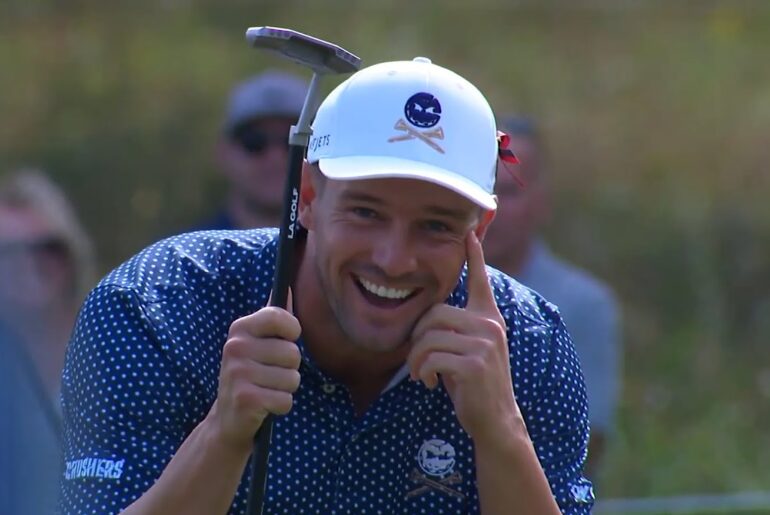Witness the highs and lows of professional golf through John Murphy’s story.
Once a rising star with a promising career ahead, Murphy now faces
the harsh realities of the sport.
Follow his journey at the Irish Challenge on the HotelPlanner Tour
as he battles to make his first cut in a year.
**Key Moments:**
– Murphy’s emotional rollercoaster on the course
– The pivotal shot that changed everything
– Heartfelt insights from Murphy and his family
– The unrelenting spirit of a golfer in pursuit of redemption
**Subscribe for more golf stories, player profiles, and tournament highlights.**
A disheartening day on the course, County Meath, Ireland. John Murphy stood on the lush green grass, his hands resting on his head in disbelief. He and his caddy had miscalculated the wind conditions, leading to a perfectly struck five iron that unfortunately landed in the pond protecting the green. From behind the green, his girlfriend’s sister gasped, “Oh no! Oh god! No!” Family members anxiously scanned the bank, hoping for a miracle. But the ball was lost, and with it, Murphy’s hopes of making his first cut in a year had sunk. Removing his gray titleist cap, Murphy ran his hands over his face and through his vibrant red hair, as if trying to shake off a recurring nightmare that had haunted him for the past 2 years. I first encountered Murphy at the 2022 Pebble Beach ProAm. His striking red hair and thick Irish accent made his heritage unmistakable. He had turned professional the previous year after an impressive college career at Louisville and soon found himself in the final group at the Dunhill Links on the European tour where he finished ninth. Although he missed the cut in California, the 27-year-old Irishman seemed destined for greatness. However, the world of professional golf is notoriously unpredictable. In 2023, Murphy secured his European tour status through Q School, but as the season unfolded, he faced significant challenges with his driver. He managed to make only three cuts out of 23 attempts, ultimately losing his card. By 2024, he found himself back on the Hotel Planner Tour, formerly known as the Challenge Tour. But the difficulties persisted. He made just two cuts out of 19 and in a flash he had lost all of his playing status. I caught up with Murphy on a Wednesday at the Irish Challenge on the HP tour. He had to rely on a lastminute sponsors invitation to enter the tournament. His lastm made cut had occurred a year prior at the same event. True to form, Murphy was friendly, optimistic, and open about his struggles. For the first time in a long while, he expressed a sense of encouragement regarding his game. “I’m not sure if it was technical or mental,” he reflected. “Those lines get blurred when you’re struggling.” He felt uplifted by a recent coaching change and believed he was gradually moving in the right direction. Despite the numerous missed cuts this year, there were glimmers of hope, including a remarkable 65 he shot a few weeks earlier, which left him just one stroke shy of the cut line. Murphy began the tournament with a solid two under 70. I plan to catch him at the turn on Friday to write about his potential first cut of the year. Sure enough, he started strong, playing his first six holes on Friday at two underpar and briefly climbed into third place early on the second day. Everything seemed to be unfolding perfectly. However, he bogeied two of the last three holes on his front nine before stepping up to the first tea, his tent. Holding a wedge in one hand and his driver in the other, he had abandoned the traditional tea, opting instead to create a turf tea with his wedge, reminiscent of Dame Laura Davies. His T-shot veered sharply to the right, prompting Murphy to drop his club in frustration. This moment served as a stark reminder that while he had made progress with his driver, the challenges were far from over. He managed to save par with a 15-oot putt. But rather than building momentum, it only provided a fleeting sense of relief. As I stood behind the tea of the next hole, Murphy approached, maintaining his friendly and upbeat demeanor. “Going to have a few pints?” he asked as he made his way to the tea of the par five. Still recovering from a couple of nights ago, I replied, eliciting a laugh from him as he walked past. A two-iron Murphy struck off the second tea, a perilous hole with water to the left and fairway bunkers to the right, showcased his undeniable talent. The ball soared with a low penetrating trajectory, taking off like a rocket and landing perfectly about 260 yds down the fairway. However, his next shot, a driver hit off the deck, was poorly executed, diving left into a deep fairway bunker 70 yd short of the green. This misstep led to a bogey, and suddenly he was inching closer to the cut line. On the third hole, I approached Murphy’s mother, Carmel, who stood alone in the knee high heather to the right of the fairway. Positioned well ahead of the other spectators following Jon, she wore sunglasses and a white cap from the Byron Nelson, a PGA Tour event Jon had participated in back in 2022. Her coat was adorned with sponsor patches from the beginning of his professional journey. I introduced myself, mentioned my intention to write about her son, and asked if I could pose a few questions. Jon deserves a medal for his resilience and perseverance,” she said, sharing insights about the dedication he puts into his game daily, despite the prolonged slump. “When I inquired whether it was difficult to watch her son struggle,” she replied, “As long as he believes, I believe.” As Murphy approached his wellexecuted drive on the third hole, his father Owen was lagging behind, slowly making his way up the fairway. He faced significant challenges with his feet. And even from a distance, his noticeable limp was apparent. He shouldn’t be out here, Carmel remarked. I told him to rest. Yet, with Jon hovering around the cutline, Owen was determined not to miss a single shot. Caramel kept her eyes glued to her son. And as we watched his approach shot land 25 ft behind the hole, she commented, “A par here will steady the ship.” She bid farewell and hurried toward the green, staying ahead of the small crowd following the group. Above the on the next hole, a missed short birdie putt on 14, followed by a par on the tricky par 36, his 15th, left Murphy at one under for the tournament, right on the cut line at that moment. The seventh hole at Kllin Castle, designed by Jack Nicholas, is a reachable par five, provided you can navigate the challenging drive. It requires a T-shot over a dense cluster of trees on the right while avoiding the deep fairway bunkers on the left. This was the type of drive Murphy had struggled with in recent years, and now the cutline loomed ominously. I stood among the right side trees near his mother, girlfriend, and her sister. Understandably, the atmosphere was tense and quiet. After Murphy’s drive landed perfectly, Carmel exhaled deeply and made her way toward the green. The green was protected by water short and left, and Murphy would need to carry the entire hazard. The wind had picked up, and from my vantage point, it felt as though it was in his favor. Near the green, the Murphy family was scattered among the heather. After the round, Murphy recounted that he had made one of his best swings of the day with the five iron, but the wind had shifted as he struck the ball, or he and his caddy had misjudged its direction. The ball splashed into the water close to the bank. The other two players in his group then hit their approach shots. And while both avoided the water, they fell significantly short, indicating that the wind had misled all three players. Murphy lingered near the edge of the pond just ahead of where he had taken his second shot. While his family rushed to the bank, the search commenced in hopes of locating the submerged titalist. After a few minutes, Jerry Zerska, Murphy’s friend and former Lewisville teammate, one of the other players in the group, formed an X with his arms. This gesture signaled to Murphy that the ball was lost. After taking a drop, Murphy barely managed to reach the green with his fourth shot, leaving him with a daunting 70-foot putt to save Parr. For the first time that day, his body language betrayed him as he stood with his hands on his head. He crouched down, rubbing his face with both hands. This was a scene that had played out far too often in his career. The bogey dropped him below the cutline for the first time all week. Just eight holes after he had been in third place on the leaderboard. On the par 3/8, he found himself in the right bunker and his shot failed to check up, rolling into the fringe. Another bogey followed. Caramel leaned against a tree behind the green as her son prepared for his parsaving putt. When it slid past the hole, she sighed, lowered her head, turned, and walked toward the next hole. As Murphy approached his 18th hole, a relatively straightforward par4. The wind picked up. There was a glimmer of hope that the cut might move later that afternoon, which it did, meaning he still had a chance to play over the weekend if he could just make a birdie. However, a weward T-shot into the tall, thick heather dashed any hopes of that. Murphy hacked it out from there and in one last desperate attempt to secure a tea time on Saturday, his pitch from 70 yards came to rest just two feet short. As he waited for his playing partners to finish, Murphy crouched again, gazing over at the 10th T. There, the featured group, including some promising young stars, was beginning its second round. The largest gallery of the week, had gathered around the tea box, cheering enthusiastically as each player was introduced. It was a harsh reminder that in just 2 years, Murphy had transitioned from being in the spotlight to becoming an afterthought. After sinking his par putt, he walked off the green. To add insult to injury, the shuttles, which typically transport players finishing on the ninth hole, a considerable distance from the clubhouse, were nowhere to be seen. Murphy began the long walk alone. But then he spotted a friend with his two young boys. He forced a smile. The friend, unsure of what to say, approached cautiously, knowing there was little that could be said to ease the situation. They embraced, and then Murphy turned his attention to the children, removing his hat and placing it on one of the young boy’s heads before handing his glove to the other. He then resumed the long trek to the clubhouse, his entourage and caddy, giving him the space he needed. He completed the walk with his head down, hands shoved deep into his front pockets. As I stood outside the scoring area, I felt a sense of unease, uncertain of what to say when he emerged from the small blue building. “John, I completely understand if you don’t want to talk,” I began. “I hate to even ask, but if you’re open to a quick chat,” Murphy interrupted me, saying, “No problem, Ryan. Unfortunately, I’m used to this.” For the next 20 minutes, Murphy spoke candidly as I asked questions I wished I didn’t have to ask. Perhaps it was because Murphy has always been so kind to me and so respected by his peers, but this was the most challenging conversation I’ve ever had with a professional golfer. His frustration was palpable. He expressed that he still felt optimistic about the direction of his game, but admitted that it was difficult to find any positives from the day. He mentioned that a couple of drives coming in were evidence that his game was improving. I didn’t have much hope when I was finishing last in every event last year, he reflected. As we spoke, a man approached and asked if he could interrupt. He turned to Murphy, explained their connection, and asked me to take a picture of the two of them, handing me his phone. Murphy forced a smile as I captured a couple of images. “Going to be around for the weekend?” the man asked, oblivious to the agonizing last hour and a half Murphy had spent watching his chances of playing the weekend slip away. “Nope, fell a couple short,” he replied. As the man walked away, Murphy turned to me and said, “Ouch, that hurts.” I shook Murphy’s hand and thanked him for his time before watching him join his family. In the brief time I’ve been writing stories, there are a few players I check on weekly to see how they are performing. John Murphy is one of those players. He is kind, thoughtful, and undeniably talented. One day in the future, I hope to see him again, but this time with his hands on his head in disbelief. Not from disappointment, but from the joy of hoisting a trophy.







